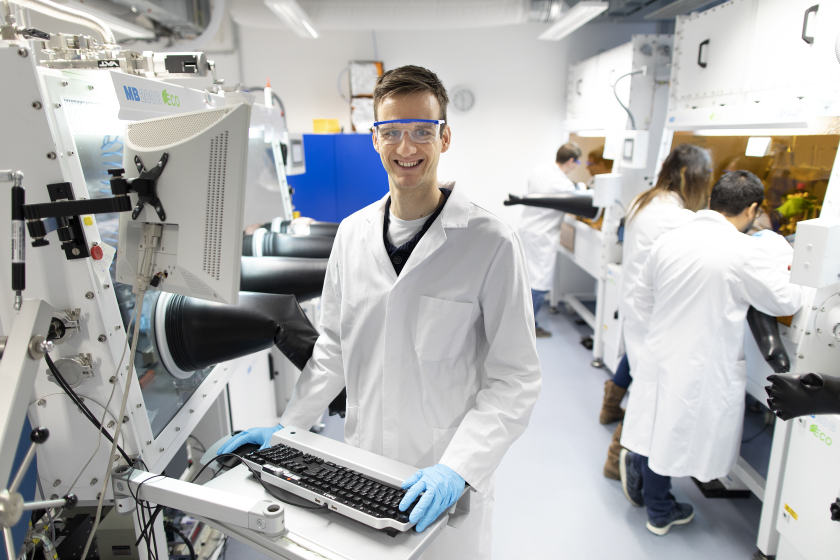Helmholtz Association promotes HZB cooperation with Slovenia on perovskite silicon tandem solar cells

Marko Jošt was a PhD student in the HySPRINT-Lab in Steve Albrecht's group. Now he will continue his research on tandem solar cells at the university of Lubljana. © M. Setzpfandt/ HZB
A HZB team has successfully raised funds from the “Helmholtz European Partnering Program” of the Helmholtz Association to expand cooperation with partners of the University of Ljubljana, Slovenia. The topics of the cooperation are tandem solar cells made of perovskite and silicon and, in particular, their precise characterisation.
Currently, most solar modules consist of silicon, a semiconductor that mainly uses the red parts of the solar spectrum to generate electricity. The combination of silicon with perovskite semiconductors therefore promises great opportunities for even higher efficiencies. Semiconductor materials from this material class convert the energy-rich, blue parts of the spectrum into electricity.
Now the HZB physicist Prof. Dr. Steve Albrecht has raised funds from the Helmholtz Association to investigate such tandem solar cells with partners from the University of Ljubljana, Slovenia. The TAPAS project is funded by the Helmholtz European Partnering programme for the next three years with 250,000 euros per year each. Following an evaluation, the funding period can be extended by two years. The Helmholtz European Partnering programme was set up to strengthen the European research area, in particular cooperation with countries in Southern, Central and Eastern Europe.
The name TAPAS stands for "Tandem Perovskite and Silicon solar cells - Advanced opto-electrical characterization, modeling and stability". Together with opto-electrical modelling, highly efficient and stable next-generation tandem solar cells are to be developed for the energy system of the future.
The Working Group for Photovoltaics and Optoelectronics at the University of Ljubljana (LPVO, headed by Prof. Dr Marko Topič) and the Helmholtz-Zentrum Berlin have established a very successful cooperation in recent years, which will be further strengthened by this funding. The aim of the cooperation is to analyse the processes that affect the stability of the modules in the field.
arö
https://www.helmholtz-berlin.de/pubbin/news_seite?nid=20800;sprache=en
- Copy link
-
Battery research with the HZB X-ray microscope
New cathode materials are being developed to further increase the capacity of lithium batteries. Multilayer lithium-rich transition metal oxides (LRTMOs) offer particularly high energy density. However, their capacity decreases with each charging cycle due to structural and chemical changes. Using X-ray methods at BESSY II, teams from several Chinese research institutions have now investigated these changes for the first time with highest precision: at the unique X-ray microscope, they were able to observe morphological and structural developments on the nanometre scale and also clarify chemical changes.
-
Hydrogen: Breakthrough in alkaline membrane electrolysers
A team from the Technical University of Berlin, HZB, IMTEK (University of Freiburg) and Siemens Energy has developed a highly efficient alkaline membrane electrolyser that approaches the performance of established PEM electrolysers. What makes this achievement remarkable is the use of inexpensive nickel compounds for the anode catalyst, replacing costly and rare iridium. At BESSY II, the team was able to elucidate the catalytic processes in detail using operando measurements, and a theory team (USA, Singapore) provided a consistent molecular description. In Freiburg, prototype cells were built using a new coating process and tested in operation. The results have been published in the prestigious journal Nature Catalysis.
-
Rutger Schlatmann re-elected as ETIP PV Chair
The European Technology and Innovation Platform for Photovoltaics (ETIP PV) was created by the European Commission in order to promote photovoltaic technologies and industries in Europe. Now, the ETIP PV Steering Committee elected a new Chair, as well as two Vice-Chairs for the term 2024 – 2026. Rutger Schlatmann, head of the division Solar Energy at the HZB, and professor at HTW Berlin, was re-elected as the ETIP PV Chair.
